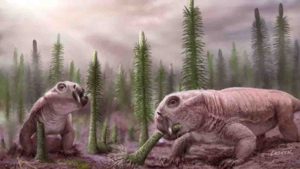
Two of Earth’s five mass extinction events — times when more than half of the world’s species died — resulted in the survival of a low number of so-called “weedy” species that spread their sameness across the world as Earth recovered from these dramatic upheavals. The findings could shed light on modern high extinction rates and how biological communities may change in the future.
David J. Button, an NC State and North Carolina Museum of Natural Sciences postdoctoral research scholar, and colleagues examined fossil records of almost 900 vertebrate species dating back between 260 and 175 million years ago — from the late Permian through the Triassic and early Jurassic periods. Two mass extinction events occurred during this time. Button says that similar patterns arising after two mass extinctions implies that other extinction events may have the same results — including current biodiversity loss.
“Mass extinctions not only reduced animal diversity, but also affected the distribution of animals and ecosystems, or biogeography,” Button said. “As species are removed by extinction, their ecological niches are left vacant. Following the extinction event, these niches are occupied by surviving and newly evolving ‘weedy’ species. These few generalists spread out and dominated for a time, leading to a low-diversity global ‘disaster fauna.'”
One of these generalists was the Lystrosaurus, a plant-eating early mammal relative that ranged from dog- to pig-sized. It had tusks to help it dig up plant matter.
The late-Permian event — occurring around 252 million years ago — allowed new groups to evolve, including the earliest dinosaurs, crocodiles and relatives of mammals and lizards, Button said. The late-Triassic event, which occurred around 201 million years ago, wiped out many major groups, setting the stage for dinosaurs to take over.
“The late-Permian event caused about 90 percent of sea life and 70 percent of land-living vertebrates to become extinct, probably as a result of climate change from hyperactive volcanism — when volcanoes spewed basalt lava and released gases into the atmosphere causing large increases in carbon dioxide and severe warming resulting in desertification,” Button said. “The late-Triassic event is also associated with volcanism.”
“Mass extinctions were global disasters that fundamentally reshaped ecosystems,” said Richard Butler, professor of palaeobiology at the University of Birmingham and a co-author of the study. “Our new analyses provide crucial data that show just how profoundly these cataclysmic events changed and influenced animal distribution.”
“The fossil record has the potential to test evolutionary hypotheses in long time spans, which is not possible if evolutionary research is limited to living plant and animals,” said Martín Ezcurra, a researcher at the Museo Argentino de Ciencias Naturales who co-authored the paper.
Identifying patterns across mass extinction events in the fossil record can help researchers make predictions about the consequences of current biodiversity loss, Button said.
“Further understanding of these ancient crises will help to inform conservation efforts to prevent modern animals from suffering a similar fate,” he added.
Graeme T. Lloyd of the University of Leeds also co-authored the paper, which is published in Nature Communications. The study was funded by a Marie Curie Actions grant (630123), a European Research Council Starting Grant (637483) and a Discovery Early Career Researcher (DE140101879) award.
Reference:
David J. Button, Graeme T. Lloyd, Martín D. Ezcurra, Richard J. Butler. Mass extinctions drove increased global faunal cosmopolitanism on the supercontinent Pangaea. Nature Communications, 2017; 8 (1) DOI: 10.1038/s41467-017-00827-7
Note: The above post is reprinted from materials provided by North Carolina State University.










